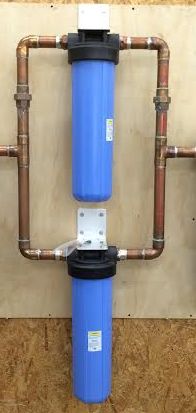How to Pick the Best Filter Cartridge
The “best” water filter cartridge is not necessarily the one that removes most contaminants or the one that treats the most gallons of water or the one that has the least pressure drop. The best for you is the one that does what is needed in your application.
This article makes some generalizations about water filter cartridges to help clarify what performance information provided by manufacturers means to the filter customer. We’re using “whole house” carbon filter cartridges, 4.5″ X 20″, treating chlorine and chloramine, to illustrate, but the principles apply as well to other filters, like sediment filters and “media” cartridges that are intended for problems like iron, turbidity, lead, and nitrate reduction.
In general terms, the more tightly the filter media is packed together, the more effective the filter is at removing contaminants, but the more it restricts the flow of water through it and the more likely it is to become clogged by particles. The looser the media is packed, the less effective the filter is at contaminant removal, but the less it restricts the flow of water and the less likely it is to be clogged. Tighter means more effective performance but greater pressure loss.
Another generalization that’s true of most cartridges is that the slower the water goes through the filter, the more effectively it treats contaminants, the longer it lasts, and the less water pressure is lost. Conversely, the faster the flow, the poorer the performance, the greater the pressure loss, and the shorter the lifespan of the filter.
The art of selecting a filter, then, is to choose one that’s tight enough to be effective but not so tight that it restricts service flow or stops up easily. It must also be large enough to accommodate the needed service flow rate. Sometimes with cartridge filters to get a larger filter the most practical approach is to install 2 or more filters in parallel. (See the picture below.)
To see how pressure drop, capacity, and micron size are related, here is a comparison of chlorine treatment figures for two 4.5″ X 20″ MatriKX carbon blocks, identical except in tightness. (Micron size is the way filter makers state tightness: the lower the micron number, the tighter the filter.)
Two Identical Carbon Block Filters of Different Micron Ratings: Chlorine Reduction
| MatriKX CTO | MatriKX CTO+ | |
| Filter Type | Coconut Shell Carbon Block | Coconut Shell Carbon Block |
| Micron Rating | Nominal 5 microns | Nominal 1 micron |
| Chlorine Removal Capacity | 34,000 gallons @ 7 gpm | 160,000 gallons @ 7 gpm |
| Pressure Drop | 8 psi @ 7 gpm | 16 psi @ 7 gpm |
| Current Retail Price | $68.00 | $89.00 |
Considerations
The very tight CTO+ would seem like the better value in terms of gallons treated per cost, but it is very unlikely that in residential use such a tight filter would treat 160,000 before it stops up. Also, the excessive pressure drop gets even worse as the filter picks up particulate. Its performance is remarkable, but it probably is not the better choice for whole house residential treatment of chlorine.
The looser CTO has half the pressure drop. Most residential water use is at a rate below 7 gpm, so you can expect the 34K capacity of the CTO to go up. We’ve found the CTO to be an excellent residential filter for water treated with chlorine.
The pair of filters compared below are identical “radial flow” granular filters. Though both are rated at 25 microns, the chloramine filter evidently uses a finer carbon and is therefore a bit more restrictive. These are very high grade radial flow cartridges, not to be confused with the standard axial flow cartridges that normally use regular-grind (not powdered) carbon and have much lower performance numbers. (Axial vs. radial explained.)
Similar Radial Flow Granular Carbon Filters: One for Chlorine, the other for Chloramine
| Pentek RFC20BB—Chlorine Grade | Pentek CRFC20BB –Chloramine Grade | |
| Filter Type | Radial Flow GAC (powdered) | Radial Flow Catalytic GAC (powdered) |
| Micron Rating | 25 Microns | 25 Microns |
| Chlorine Removal Capacity | 70,000 gallons @ 4 gpm | Unknown |
| Chloramine Removal Capacity | Unknown |
10,000 gallons @ 5 gpm 25,000 gallons @ 2.5 gpm |
| Pressure Drop |
0.9 psi @ 4 gpm 2 psi@ 7 gpm 4 psi @ 11 gpm |
1 psi @ 2.5 gpm 2.5 psi @ 5 gpm 5 psi @ 7 gpm |
| Current Retail Price | $95.00 | $168.00 |
Considerations
Reducing the flow rate more than doubles the lifespan of the chloramine cartridge. While this ratio doesn’t apply everywhere, as a general rule cutting the flow rate through the filter significantly adds to its life expectancy, adds to its efficiency, and reduces pressure drop. Therefore, running two filters in parallel more than doubles the valve of a single filter. In many cases using multiple filters actually costs less than using one, plus you get lower pressure drop.
Split installation: each filter gets half the flow rate. Efficiency goes up, pressure drop goes down, and cost goes down.
With a flow rate of 5 gpm, one filter treats 10,000 gallons with a pressure drop of 2.5 psi, but two filters treat 50,000 gallons with a pressure drop of 1 psi. What’s more, operation cost is 1.6 cents per gallon for one filter and 0.66 cents for two.
Flow rate matters!





